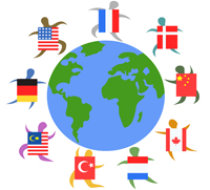Acculturation and Adaptation of Immigrant Youth
The seminar on “Acculturation and Adaptation of Immigrant Youth” was held on 19 April in the ILSCR. The lecturer was John Berry, professor emeritus in Queen’s University of Kingston, Canada.
Immigration is a worldwide phenomenon, even in societies that do not seek it. Following immigration, ethnocultural groups often become established and continue over generations. Public debates about immigration, immigrants and ethnocultural groups are often based on prejudice and self-interest. Research can contribute to a less biased public discussion on immigration and intercultural relations and can also inform public policy and program development. In most plural societies, public debate has come to be focused on immigrant and ethnocultural youth.In some cases, youth are viewed as problems, with low educational achievement, and a high level of social problems. One basis for these presumed difficulties is the set of challenges presented by living in two cultures. This is especially the case when the cultures of origin and of settlement differ with respect to values. The experience of discrimination and exclusion are also considered to be a major challenge for youth.In some societies, it is not only these educational and social issues that are of concern. There are other issues such as underemployment, and gang activity. In some cases, the radicalisation if immigrant youth has become a concern, in which youth can even turn against the larger society. One concept that has guided the examination of these issues is that of acculturation.
Acculturation is the process of cultural and psychological change following contact between cultural groups and their individual members. It takes place in both groups and all individuals. Although one group is usually dominant over the others, successful outcomes require mutual accommodation among all groups and individuals living together in the diverse society. How individuals and groups seek to acculturate has been examined using the concept of acculturation strategies. Groups and individuals in hold differing views about how to relate to each other and how to change. These views are based on two underlying issues: maintenance of heritage culture and identity to sustain cultural communities and participation with other groups in life of the national society. Their intersection produces 4 acculturation strategies, in both groups in contact. How individuals and groups seek to acculturate has been examined using the concept of acculturation strategies. Integration/Multiculturalism are defined by holding a positive orientation to both maintenance of heritage culture and identity to sustain cultural communities and participation with other groups in life of the national society. Assimilation/Melting Pot exist when there is negative orientation to first, and a positive one to second. Separation/Segregation exist when there is a positive orientation to first, and a negative one to second. Marginalisation/Exclusion exist when there are negative orientations to both issues.
John Berry presented the results of the International Comparative Study of Ethnocultural Youth (ICSEY). 13 societies of settlement were examined (USA, Canada, Australia, New Zealand, Israel, and recent societies of settlement France, Germany, Portugal, Norway, Sweden, Finland, The Netherlands and Great Britain), including 32 immigrant groups (immigrant youth N =5366 (aged 13-18); immigrant parents N =2302; national youth N = 2631 (aged 13-18); national parents N = 863). Using 12 intercultural variables, cluster analysis yielded four acculturation profiles: integration: 36.4% (oriented to both cultures); separation: 22.5% (oriented to heritage); assimilation: 18.7% (oriented to national); marginalisation: 22.4% (oriented to neither). Respondents were asked to indicate whether they had been treated unfairly because of their ethnic group. Discrimination was the single most important contributor to not achieving integration, and to being marginalized and it was the single largest predictor of poor psychological and sociocultural adaptation. There are two distinct ways in how well people adapt to acculturate: psychological and sociocultural. There are systematic relationships between how and how well immigrant youth adapt to acculturation: Integration/Multiculturalism clearly serves as the most favourable strategy for immigrant youth well-being. This pattern corresponds with most previous results from research with adult immigrants.
As a conclusion, John Berry claimed that, if a society is culturally diverse, the best policy to promote positive adaptation is to accept, promote and support this diversity through Integration/Multiculturalism policies. In the national society, public policies of Multiculturalism, supporting the integration of, and security for, all individuals and groups, will serve the general good more than any of the other ways of acculturating. For individuals, general dissemination of information and personal counseling are important in order for youth to understand the benefits of engaging both cultures in a balanced way (integration), and avoiding becoming marginalized.
Acculturation and Adaptation of Immigrant Youth
Olga Pavlenko

